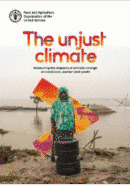Publications
Social protection as a pathway to sustaining peace
Global crises are becoming the new normal. From climate change to the contemporary food price crisis, vulnerable populations – and especially rural people – are facing increasingly difficult odds of flourishing. Such challenges are even more pronounced where there is conflict, whose multidimensional nature demands to direct more attention to its drivers and impacts. this paper discusses how social protection can sustain peace efforts by understanding peace not as an outcome but, rather, as an ongoing process.
FAO’s corporate brochures not only answer such questions but correlate them with broader subjects – the bioeconomy, say, or global trade – and tell you what the Organization is doing about them in policy and practical terms. Tone-wise, the brochures stand where the lighter side of academic literature meets the weightier side of ground reportage. Each one is themed around one of FAO’s priority areas of work, such as climate action or the Sustainable Development Goals (SDGs).
This report assembles an impressive set of data from 24 low- and middle-income countries in five world regions to measure the effects of climate change on rural women, youths and people living in poverty. It analyses socioeconomic data collected from 109 341 rural households (representing over 950 million rural people) in these 24 countries. These data are combined in both space and time with 70 years of georeferenced data on daily precipitation and temperatures. The data enable us to disentangle how different types of climate stressors affect people’s on-farm, off-farm and total incomes, labour allocations and adaptive actions, depending on their wealth, gender and age characteristics.
In December 2023, FAO published six “Trade Policy Briefs: FAO Support to the WTO Negotiations at the 13th Ministerial Conference”: (1) Developments and prospects in the international cotton market; (2) Improving food safety to foster trade; (3) The importance of international trade for fisheries and aquaculture products; (4) The WTO Agreement on Fisheries Subsidies and the role of FAO; (5) Trends in inclusion of environmental related provisions linked to the agriculture, fisheries, and forestry sectors in regional trade agreements; and (6) Price transmission in food markets. Check out the Trade Policy Briefs here.
With the slogan #LovePulses for a healthy diet and planet, this celebration presents a unique opportunity to raise public awareness about pulses and the fundamental role they play in the transformation to more efficient, inclusive, resilient and sustainable agrifood systems for better production, better nutrition, a better environment, and a better life, leaving no one behind. This “get started” guide highlights the theme for the Day in 2024: "Pulses: nourishing soils and people", as well as key actions that everyone can take to celebrate the World Pulses Day.
Building on the success of the International Year of Pulses in 2016, which was implemented by FAO, the United Nations General Assembly designated 10 February as World Pulses Day.






